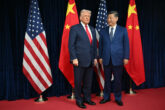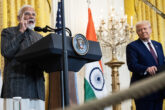March 29, 2020
Forging an Alliance Innovation Base
Executive Summary
This report presents a blueprint for a community of technology innovation and protection anchored by America and its allies. Unless the United States builds this community—an “alliance innovation base”—it will steadily lose ground in the contest with China to ascend the commanding technological heights of the 21st century. Given that technology will increasingly determine future military advantage, underpin economic prosperity, and function as a tool for promoting liberal and illiberal visions of domestic governance, the stakes could not be higher.
To compete, China is leveraging its formidable scale—whether measured in terms of research and development (R&D) expenditures, data sets, scientists and engineers, venture capital, or the reach of its leading technology companies. The only way for the United States to tip the scale back in its favor is to deepen cooperation with allies. The global diffusion of innovation also places a premium on aligning U.S. and ally efforts to protect technology. Unless coordinated with allies, tougher U.S. investment screening and export control policies, for example, will feature major seams that Beijing can exploit.
America’s current approach to allies on technology innovation and protection remains a work in progress. In recent years, animated by concerns about China, the United States has made a concerted effort to step up engagement with allies in both areas. Existing mechanisms for deepening innovation with allies include technology scouting programs, multilateral cooperative frameworks, rapid innovation initiatives, and bilateral projects. However, these mechanisms at times lack sufficient resourcing, move too slowly, or feature rigid constraints on participation. U.S. instruments for working with allies on technology protection also contain major points of weakness. Multilateral export control regimes, though inclusive, are ponderous. The extraterritorial reach of U.S. export control laws can generate unintended obstacles to technology collaboration with allies. Bilateral and minilateral consultations on protection lack positive incentives to motivate allies to incur immediate costs such as forgoing technology sector investments from China.
Design Principles
The strengths and weaknesses of the current American approach inform this report’s blueprint for an alliance innovation base. So do the aspirations and potential contributions of individual U.S. allies. The report focuses in particular on Japan, given its deep-seated concerns about China’s technology ascendance, intense interest in protection, and enduring strengths in certain types of technology development. Recognizing that these qualities also render Japan unrepresentative, this report further examines three additional U.S. allies—Australia, Israel, and Norway—countries that collectively feature significant diversity in their perceptions of China and approaches to technology innovation and protection.
The following design principles for an alliance innovation base reflect a detailed examination of these four countries as well as lessons learned from best practices and pitfalls of current U.S. engagement with allies on technology innovation and protection.
- Adopt a flexible architecture for an alliance innovation base that can accommodate countries with variable threat perceptions and distinct capabilities.
- Create tangible economic benefits to incentivize allies to adopt tougher technology protection measures.
- Focus technology cooperation on solving narrowly scoped problems in order to manage divergent views on the nature of the international threat environment.
- Foster a “benefit together” ethos that chips away at deeply rooted preferences for spending and procuring domestically.
- Incorporate politicians, publics, and the private sector from the outset to build critical momentum in support of an alliance innovation base.
A Blueprint for Moving Forward
No single action by the United States will galvanize an alliance innovation base. Rather, the task for Washington is to construct a community of technology innovation and protection link by link, proceeding along five main lines of effort:
Strengthen America’s Toolkit for Technology Engagement
- Increase resources for major technology scouting programs. For example, Congress in the next National Defense Authorization Act (NDAA) and defense appropriation should expand funding for the Office of Naval Research Global and the Foreign Comparative Testing Program.
- Leverage U.S. Defense Attaché Offices. The Defense Department should add technology scouting to the responsibilities of Defense Attachés posted to U.S. embassies in allies with robust innovation ecosystems.
- Internationalize startup-focused engagements. The Defense Innovation Unit, which today has a primarily domestic mandate, should over time go global, beginning with roadshows to allies, and culminating with a permanent presence overseas.
Build Ally Awareness and Capacity
- Upgrade information sharing with ally governments. Making releasable to allies the most granular list of critical technologies the U.S. government has compiled would help to align protection measures.
- Promote broad-based awareness of China’s actions. The United States should undertake a comprehensive public diplomacy campaign to highlight China’s pursuit of technology within the innovation ecosystems of allies.
- Build ally capacity to protect technology. Where possible, Washington should help ally intelligence and law enforcement agencies to retool for tracking and countering Beijing’s technology acquisition efforts.
Launch New Collaborative Platforms
- Establish bilateral national security innovation funds. These funds could support a range of initiatives, from quickfire seed projects to road test high-risk ideas to incubators for startups innovating at the nexus of defense and commercial applications.
- Form a military test facility consortium. Participating governments would pool access to high-demand, low-availability equipment and ranges in exchange for the sharing of test results with other members of the consortium.
- Launch a cross-national platform to build new companies. This platform would bring together innovators and entrepreneurs from the United States and participating allies to develop new businesses around specific national security themes.
Create Positive Incentives for Technology Protection
- Reduce barriers to investment in the United States for allies committed to technology protection. As an initial step, the Treasury Department should make explicit what investment screening and export control standards allies must meet to qualify as “excepted states” under current regulation governing U.S. national security review of foreign investments.
- Invite U.S. allies to join an “ITAR Free Zone.” Washington should announce its intent to eliminate onerous licenses controlling the bilateral flow of U.S. defense goods, services, and knowledge with and among allies that meet concrete technology protection standards.
Leverage the U.S.-Japan Alliance
- Announce a government data pooling partnership. The United States and Japan should unveil an initiative to pool select, curated datasets held by each government for use by companies and innovators in each country.
- Spearhead export controls on semiconductor manufacturing equipment. To extend their current advantage in this critical technology area, the United States and Japan should work with the Netherlands – the other market leader – to impose new restrictions on sales to China.
- Initiate a bilateral dialogue on research integrity. Washington and Tokyo should convene a regular dialogue of administrators from their top technology universities to develop best practices for managing risks posed by Chinese researchers and institutional partnerships.
Download the full report.
More from CNAS
-
Indo-Pacific Security / Energy, Economics & Security
How to Win the Economic War with ChinaTrump's approach to China has run aground, giving Beijing unprecedented advantage in the economic conflict....
By Edward Fishman & Julian Gewirtz
-
America’s Self-Loathing Is a Losing Hand
This article was originally published in The Washington Post.Around 10 years ago, the United States began a historic shift in its grand strategy toward China, abandoning the b...
By David Feith
-
Indo-Pacific Security / Energy, Economics & Security / Technology & National Security
Selling AI Chips Won’t Keep China Hooked on U.S. TechnologyU.S. policy should not rest on the illusion that selling chips can trap China inside the American tech ecosystem....
By Janet Egan
-
Will New Delhi-Beijing Move Beyond Friction Points? | Ex-White Official On India-China Reset
Prime Minister Narendra Modi on Friday said that India and China, as two major economies, must work together to bring stability to the global economic order. NDTV's Gaurie Dwi...
By Lisa Curtis








